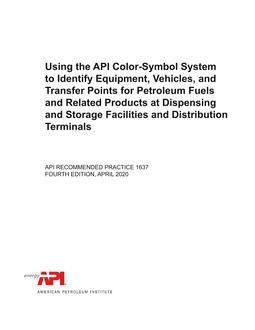No products
 View larger
View larger
API RP 1637
M00042295
New product
API RP 1637 Using the API Color-Symbol System to Identify Equipment, Vehicles, and Transfer Points for Petroleum Fuels and Related Products at Dispensing and Storage Facilities and Distribution Terminals, Fourth Edition
standard by American Petroleum Institute, 04/01/2020
Full Description
This recommended practice describes a system for marking equipment used to store and handle bulk petroleum, alcohol-blended petroleum, and biodiesel products. The equipment marking Color-Symbol system described in this recommended practice facilitates easy identification of products by means of colors, symbols, and alphanumeric designations. The principal purpose of this marking system is to identify product transfer points for tank-truck loading and unloading at distribution terminals and retail outlets to prevent errors in product handling.The marking system described in this recommended practice does not cover aviation fuels.
In stock
More info
Using the API Color-Symbol System to Identify Equipment, Vehicles, and Transfer Points for Petroleum Fuels and Related Products at Dispensing and Storage Facilities and Distribution Terminals
API RECOMMENDED PRACTICE 1637 FOURTH EDITION, APRIL 2020
Special Notes
API publications necessarily address problems of a general nature. With respect to particular circumstances, local, state, and federal laws and regulations should be reviewed.
Neither API nor any of API's employees, subcontractors, consultants, committees, or other assignees make any warranty or representation, either express or implied, with respect to the accuracy, completeness, or usefulness of the information contained herein, or assume any liability or responsibility for any use, or the results of such use, of any information or process disclosed in this publication. Neither API nor any of API's employees, subcontractors, consultants, or other assignees represent that use of this publication would not infringe upon privately owned rights.
API publications may be used by anyone desiring to do so. Every effort has been made by the Institute to assure the accuracy and reliability of the data contained in them; however, the Institute makes no representation, warranty, or guarantee in connection with this publication and hereby expressly disclaims any liability or responsibility for loss or damage resulting from its use or for the violation of any authorities having jurisdiction with which this publication may conflict.
API publications are published to facilitate the broad availability of proven, sound engineering and operating practices. These publications are not intended to obviate the need for applying sound engineering judgment regarding when and where these publications should be used. The formulation and publication of API publications is not intended in any way to inhibit anyone from using any other practices.
Any manufacturer Color-Symbol equipment or materials in conformance with the Color-Symbol requirements of an API standard is solely responsible for complying with all the applicable requirements of that standard. API does not represent, warrant, or guarantee that such products do in fact conform to the applicable API standard.
All rights reserved. No part of this work may be reproduced, translated, stored in a retrieval system, or transmitted by any means, electronic, mechanical, photocopying, recording, or otherwise, without prior written permission from the publisher. Contact the Publisher, API Publishing Services, 200 Massachusetts Avenue, NW, Suite 1100, Washington, DC 20001-5571.
Copyright © 2020 American Petroleum Institute
ii
Foreword
Nothing contained in any API publication is to be construed as granting any right, by implication or otherwise, for the manufacture, sale, or use of any method, apparatus, or product covered by letters patent. Neither should anything contained in the publication be construed as insuring anyone against liability for infringement of letters patent.
The verbal forms used to express the provisions in this document are as follows.
Shall: As used in a standard, “shall” denotes a minimum requirement to conform to the standard.
Should: As used in a standard, “should” denotes a recommendation or that which is advised but not required to conform to the standard.
May: As used in a standard, “may” denotes a course of action permissible within the limits of a standard. Can: As used in a standard, “can” denotes a statement of possibility or capability.
ThisdocumentwasproducedunderAPIstandardizationproceduresthatensureappropriatenotificationandparticipation in the developmental process and is designated as an API standard. Questions concerning the interpretation of the content of this publication or comments and questions concerning the procedures under which this publication was developed should be directed in writing to the Director of Standards, American Petroleum Institute, 200 Massachusetts Avenue, Suite 1100, Washington, DC 20001. Requests for permission to reproduce or translate all or any part of the material published herein should also be addressed to the director.
Generally, API standards are reviewed and revised, reaffirmed, or withdrawn at least every five years. A one-time extension of up to two years may be added to this review cycle. Status of the publication can be ascertained from the API Standards Department, telephone (202) 682-8000. A catalog of API publications and materials is published annually by API, 200 Massachusetts Avenue, Suite 1100, Washington, DC 20001.
Suggested revisions are invited and should be submitted to the Standards Department, API, 200 Massachusetts Avenue, Suite 1100, Washington, DC 20001, standards@api.org.
iii
Contents
Page
Scope 1
System Purpose 1
System Design 1
Included Products 1
Normative References 2
Color-Symbol System 3
General (See Figure 1) 3
Gasoline E10 3
Gasoline E0 3
Gasoline with Alternative Blends 3
Racing Fuel 4
Ethanol Blends 4
Diesel 4
Diesel Exhaust Fluid 4
Fuel Oil/Heating Fuels 5
Used Oil 5
Observation/Monitoring Wells 5
Vapor Recovery 5
Denatured Ethanol 5
System Application 5
General 5
Storage and Distribution Terminals 8
Delivery Vehicles 9
Dispensing Facilities 9
Bibliography 11
Figures
Equipment Color-Symbol System (Part 1) 6
Equipment Color Symbol System (Part 2) 7
Equipment Color Symbol System (Part 3) 8
Painting the Fill or Access Point Cover and Painting the Rim of the Fill or Access Point 9
Painting the Fill or Access Point Cover and Placing a Collar or Permanent Label in or Around
the Fill or Access Point 10
v

